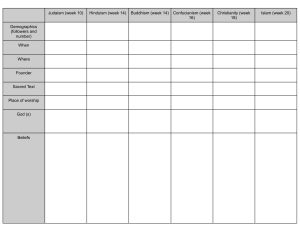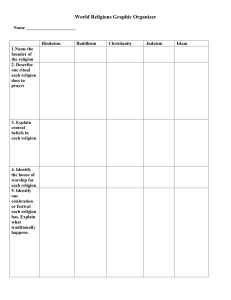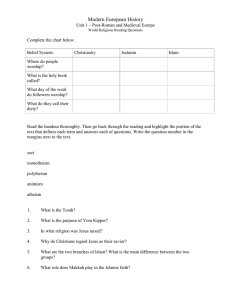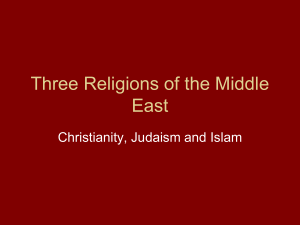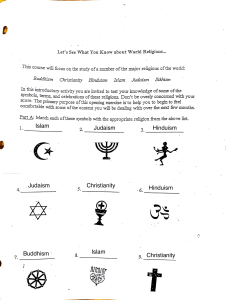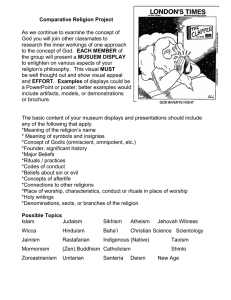Uploaded by
Aaleen Kttk
Sociology of Religion: Definitions, Theories, and World Religions
advertisement
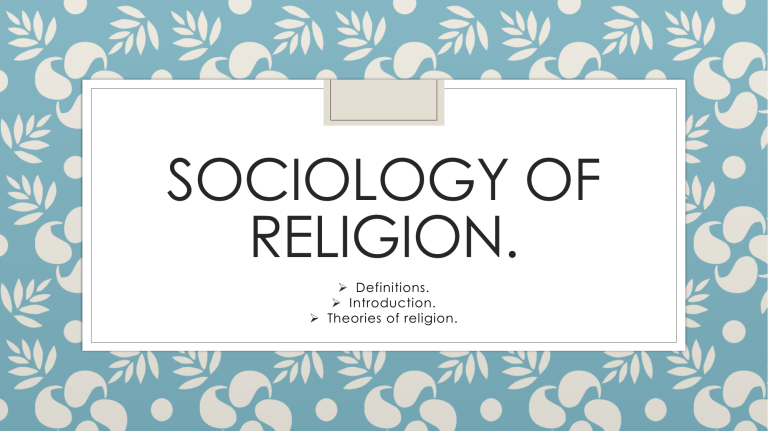
SOCIOLOGY OF RELIGION. Definitions. Introduction. Theories of religion. 1. SOCIOLOGY AND RELIGION: ◦ Religion is a set of organized beliefs, practices, and systems that most often relate to the belief and worship of a controlling force, such as a personal god or another supernatural being. ( definition of religion). ◦ Sociology of religion seeks to understand the social context of human-constructed aspects of religion. ◦ Sociology of religion is interested in the involvement, participation and contribution of religion in the society. Sociologists believe that studying society through religious perspective will enhance peace, order and stability in the society. ◦ INTRODUCTION: ◦ Religion is a social institution composed of a combined system of beliefs, symbols, and rituals based on some sacred or supernatural realm that guides human behavior, gives meaning to life, and unites believers into a community. ◦ Religion is sometimes thought of as a platform for the expression of spirituality, or the relationship between the individual and something larger than oneself, such as a broader sense of connection with the surrounding world. ◦ Spirituality involves inner, individual feelings and experiences ◦ Religion involves external beliefs, rituals and deities ◦ Both religion and spirituality involve faith, a confident belief that cannot be proven or disproven but is accepted as true. ◦ The sociological investigation of religion reflects fair-minded scholarship, meaning that social scientists do not seek to make value judgments about religious beliefs or to determine whether particular religious bodies are “right” or “wrong.” ◦ Religious experience refers to the principle or sensation that we are connected to “the divine.” ◦ Religious rituals are behaviors or practices that are either required or expected of the members of a particular group. ◦ Not all sociologists believe that the sacred covering accurately describes modern religion. Some believe that the religious marketplace is a better comparison. ◦ 2. TYPES OF BELIEFS IN RELIGION: The words monotheism and polytheism share some of the same roots: the element the- is a form of Theo a Greek root meaning “god,” and the suffix -ism is used in nouns that refer to specific doctrines or beliefs. The difference is in the beginning: mono- means “one,” while poly- means “multiple. MONOTHEISM: ◦ Monotheism is the belief or doctrine that there is one—and only one—god. ◦ EXAMPLE: Judaism, Christianity and Islam are both well-known examples of monotheism. ◦ POLYTHEISM: Polytheism is the belief or doctrine that there are multiple gods or goddesses. ◦ EXAMPLE: The most widely-practiced polytheistic religion is Hinduism, which has many different branches. The religions of many different Ethnic peoples in different places are polytheistic. Ancient Greek people practiced polytheistic religions whose many gods we now know as part of what we call tradition. ◦ PATRIARCHAL AND MATRIARCHAL RELIGION: ◦ In patriarchal religion, the beliefs and practices of the religion are based on male power and authority. ◦ In matriarchal religion, the beliefs and practices of the religion are based on female power and authority. (This religion focuses on a goddess or goddesses). ◦ 3. FINCTIONS OF RELIGION: ◦ Social Control: • Religious beliefs can influence the conduct of those who believe in them. It keeps people ‘in line’ through folkways and values. Religious permissions play a significant role in this regard. ◦ • Judgment of Right and Wrong: It helps to determine what is considered acceptable behavior and what is not. e.g. Islam divides actions into two categories; the right acts lead to Heaven and the wrong acts to Hell. ◦ • Preservation of Values: • Religion preserves social values which have been derived from it. The social values are closely linked with the religious teachings, therefore those acts are sentenced or forbidden that are not ‘in line’ with the religious teachings. ◦ 4.THEORIES OF RELIGION: ◦ FUNCTIONALIST PERSPECTIVE (Durkheim). 1. he structural-functional approach to religion has its roots in Emile Durkheim’s work on religion. 2. Durkheim proposed that religion has three major functions in society: it provides social cohesion to help maintain social solidarity through shared rituals and beliefs, social control to enforce religious-based morals and norms to help maintain conformity and control in society, and it offers meaning and purpose to answer any existential questions. 3. Durkheim placed himself in the positivist tradition, meaning that he thought of his study of society as calm and scientific. He was deeply interested in the problem of what held complex modern societies together. Religion, he argued, was an expression of social cohesion. 4. With totemism he meant that each of the many clans had a different object, plant, or animal that they held sacred and that symbolizes the clan. Durkheim saw totemism as the original and simplest form of religion. According to Durkheim, the study of this simple form of religion could provide the building blocks for more complex religions. He stated that moralism cannot be separated from religion. ◦ CONFLICT PERSPECTIVE: ◦ Religion has all of these benefits, but, according to conflict theory, it can also reinforce and promote social inequality and social conflict. This view is somewhat inspired by the work of Karl Marx, who said that religion was the “opiate of the masses” (Marx, 1964). By this he meant that religion, like a drug, makes people happy with their existing conditions. Marx repeatedly stressed that workers needed to rise up and overthrow the bourgeoisie. To do so, he said, they needed first to recognize that their poverty reduced from their oppression by the bourgeoisie. But people who are religious, he said, tend to view their poverty in religious terms. They think it is God’s will that they are poor, either because he is testing their faith in him or because they have violated his rules. Many people believe that if they endure their suffering, they will be rewarded in the afterlife. Their religious views lead them not to blame the capitalist class for their poverty and thus not to revolt. For these reasons, said Marx, religion leads the poor to accept their fate and helps maintain the existing system of social inequality. ◦ SYMBOLIC INTERACTIONALIST: ◦ It examines the role that religion plays in our daily lives and the ways in which we interpret religious experiences. ◦ Symbolic interactionist study the ways in which people practice their faith and interact in houses of worship and other religious settings, and they study how and why religious faith and practice have positive consequences for individual psychological and physical well-being. ◦ Religious symbols indicate the value of the symbolic interactionist approach. A crescent moon and a star are just two shapes in the sky, but together they constitute the international symbol of Islam. A cross is merely two lines or bars in the shape of a “t,” but to Christians it is a symbol with deeply religious significance. A Star of David consists of two covered triangles in the shape of a six-pointed star, but to Jews around the world it is a sign of their religious faith. ◦ Religious rituals and ceremonies also explain the symbolic interactionist approach. They can be deeply intense and can involve crying, laughing, screaming, illusory conditions, a feeling of oneness with those around you, and other emotional and psychological states. For many people they can be transformative experiences, while for others they are not transformative but are deeply moving nonetheless. ◦ 5. MAJOR RELIGIONS OF WORLD: ◦ CHRISTIANITY: ◦ Christianity is the most widely practiced religion in the world, with more than 2 billion followers. ◦ Jesus is the Son of God and in normal Christian denominations he is God the Son, the second Person. He is believed to be the Jewish messiah (the Christ) who is prophesied in the Hebrew Bible, which is called the Old Testament in Christianity. he died for the forgiveness of sins and was raised from the dead and exalted by God, and will return soon at the inception of God's kingdom. ◦ Christianity Beliefs ◦ Some basic Christian concepts include: ◦ Christians are monotheistic, i.e, they believe there’s only one God, and he created the heavens and the earth. This divine Godhead consists of three parts: the father (God himself), the son (Jesus Christ) and the Holy Spirit. ◦ The essence of Christianity revolves around the life, death and Christian beliefs on the resurrection of Jesus. Christians believe God sent his son Jesus, the messiah, to save the world ◦ Christians contend that Jesus will return to earth again in what’s known as the Second Coming. ◦ SYMBOLE OF RELIGON: ◦ The cross is a symbol of Christianity. ◦ CEREMONIES: ◦ The most important Christian holidays are Christmas (which celebrates the birth of Jesus) and Easter (which commemorates the resurrection of Jesus). ◦ THE CHRISTIAN BIBLE: ◦ The Christian Bible is a collection of 66 books written by various authors. It’s divided into two parts: The Old Testament and the New Testament. ◦ The Old Testament, which is also recognized by followers of Judaism describes the history of the Jewish people, specific laws to follow&details the lives of many prophets, and predicts the coming of the Messiah. In new testament it is said that how the messiah will come when the end of the world is near. ◦ 10 COMMANDMENTS OF JESUS: ◦ Love God. ◦ Love your neighbor as yourself. ◦ Forgive others who have wronged you. ◦ Love your enemies. ◦ Ask God for forgiveness of your sins. ◦ Jesus is the Messiah and was given the authority to forgive others. ◦ Repentance of sins is essential. ◦ Don’t be hypocritical. ◦ Don’t judge others. ◦ The Kingdom of God is near. It’s not the rich and powerful—but the weak and poor— who will inherit this kingdom. ◦ PLACE OF WORSHIP: ◦ . A church is central to the Christian faith, and it is where the community comes together to worship and praise God ◦ FORBIDDEN FOODS: ◦ The only dietary restrictions specified for Christians in the New Testament are to "withdraw from food sacrificed to idols, from blood, from meat of inhibited animals“. ◦ JUDAISM: ◦ Judaism is the world’s oldest monotheistic religion, dating back nearly 4,000 years. Followers of Judaism believe in one God. God first revealed himself to a Hebrew man named Abraham, who became known as the founder of Judaism. ◦ Jews believe that God made a special agreement with Abraham and that he and his descendants were chosen people who would create a great nation. ◦ JUDAISM BELIEVS: Most Jews (with the exception of a few groups) believe that their Messiah hasn’t yet come but will one day. ◦ PLACE OF WORSHIP: Jewish people worship in holy places known as synagogues, and their spiritual leaders are called rabbis. ◦ SYMBOLE OF JUDAISM: The six-pointed Star of David is the symbol of Judaism. ◦ HOLY BOOK: TORAH( torait) The Jewish sacred text is called the Tanakh or the “Hebrew Bible.” It includes the same books as the Old Testament in the Christian Bible, but they’re placed in a a little different order. ◦ JEWISH CEREMONIES: ◦ Passover: This holiday lasts seven or eight days and celebrates Jewish freedom from slavery in Egypt. ◦ Rosh Hashanah: known as the Jewish new year. ◦ Yom Kippur: This “Day of Apology” is considered the holiest day of the year for Jews who typically spend it fasting and praying. ◦ Hanukkah: This Jewish celebration, also known as the “Festival of Lights,” lasts eight days. ◦ KOSHER FOODS: ◦ meat(cow,sheep,goats), milk ,fish. Pork is haram. ◦ 3: ISLAM: ◦ Islam is the second largest religion in the world after Christianity with about 1.91 billion people. People ◦ who follow Islam are known as Muslims. Islam was created in the 7 th century, the youngest religion in ◦ the world. Islam was started in Mecca Saudi Arabia during the time of Prophet Muhammad’s life. ◦ Muslims are monotheistic and worship one God who is known as Allah. Followers of Islam believe that ◦ nothing can happened without the permission of Allah. Islam teaches that Allah’s word was revealed to ◦ the prophet Muhammad through the angel Gabriel. Muslims contend that Muhammad was the final ◦ prophet. ◦ PLACE OF WORSHIP ◦ Mosques are places where Muslims worship together. Muslims can also pray separately at home on ◦ Janyamaz. Some important Islamic holy places :include the Ka’aba shrine in Mecca, the Al-Aqsa mosque in Jerusalem, and the Prophet Muhammad’s mosque in Medina. ◦ SYMBOL: The symbol of Islam is Crescent and star. ◦ HOLY BOOK OF ISLAM: The holy book of Islam is Quran. ◦ HALAL AND HARAM FOOD: In Islam pork and any product prepared with alcohol or animal fats is haram. ◦ 4: BUDDHISM: ◦ Buddhism is a faith that was founded by Siddhartha Gautama (the Buddha) more than 2,500 years ago in India. ◦ There are 507 million followers of Buddhism. Buddhism one of the major world religions. ◦ Buddhists do not believe in any kind of god because they believe that the human life is one of suffering, and that meditation, spiritual and physical labor, and good behavior are the ways to achieve enlightenment, or nirvana. ◦ PLACE OF WORSHIP: Followers of Buddhism can worship in temples or in their own homes. ◦ SYMBOL: There is no single symbol for Buddhists because there are number of images of Buddhists. ◦ HOLY BOOK OF BUDDHISM: There are three holy books of Buddhism, Tipitaka, Sutras and the book of the dead. ◦ HALAL AND HARAM FOOD: ◦ Buddhists do not eat any kind of meat or fish. They are purely vegetarian. ◦ HOLLYDAYS IN BUDDHISM: ◦ Magha Puja Day and Sangha Day This celebration usually occurs on the day of full moon in March. On this day, it is believed that the Buddha gave his disciples a message. ◦ Buddhist New Year For three days after the first full moon of April. ◦ Wesak birth and death of Buddha is remembered. ◦ Dharma Day This day honors the start of the teachings of Buddha ◦ 6: ELEMENTS OF RELIGION: ◦ Following are the 7 most basic elements of religion in sociology. ◦ Beliefs on supernatural. It is the awareness of brain we have beliefs in one God, Dooms day, Angels, Sacred books, good and bad Luck, while Hindus believe in more than one God. ◦ ACTS DEFINED AS SINFUL Every religion define some acts as profane or sinful. The follower of religion avoid sinful activities because it is prohibited. It can be food, acts like murder, abusing etc. ◦ SOME METHOD OF SALVATION: All religion consider salvation as an ultimate goal of life. Every religion have their own method of salvation. ◦ PROCEDURE OF WORSHIP: Everyone religion has its own specific procedure of worshipping. The follower of religion worship the supernatural power in the form of a statue. ◦ PLACE OF WORSHIP: Every religion has its own definite place of worship in which people offer their prayers. The Hindu worship in a Temple, Muslims in a Mosque, Christians in Church etc. : RITUAL: Every religion have different rituals which are practically performed. These rituals are performed by individual or group of individuals with reference to their religion. If an individual failed to perform rituals related to their religion it is considered as a sin. For example Muslims do Namaz alone or collectively in a Mosque. Hindus pray in temples and Christians give flower to Jesus Christ and then pray. BELIEF IN THE HOLY: In every religion people belief in different sacred things and they started to believe that this is the heart of the religion. This belief in the holy things are mentally constructed because they are not visible. It is only based on faith rather than evidence. For example in Hindu religion cow is holy because of the faith of Hindus. ◦ 7. CATEGORIES OF RELIGION: ◦ Prayer: addressing the super natural, custom in all cultures ,public or private, includes exorcism and speaking to the soul of a human. Prayers reflect culturally conceived nature of divine, frequency important in many cultures. ◦ Music: singing and playing instruments. Dancing- can represent supernatural world, means of telling religious stories and often involves manipulation of physical symbols. ◦ Exhoration: addressing another human being...like preaching ◦ Reciting: the code mythology, morality, and other aspects of the belief system. Sacred oral or written literature, which asserts what is truth in religion. Myths, moral injunctions. ◦ Simulation: imitating things, ritual to control the supernatural. Copied magic, contagious magic involves taking something from a person like voodoo. Involves ritual procedure, divination like reading palms etc. ◦ Mana: touching things the passage of valuable qualities from touching things like Apollo or baseball players. ◦ Taboo: not touching things to come into contact with certain objects or individuals. ◦ Feast: eating or drinking a sacred meal that contains a supernatural force or power. Power believed to be derived from spiritual being. Power safely acquired if consumed in context of ritual. ◦ Sacrifice: immolation, offerings and dues. ◦ Worshipers: processions meetings and convocations, social expression of religious behavior all come together at some time. ◦ Inspiration: sudden, spontaneous interruptions of mood and thought. Auditory or visual hallucination thought to be communication for the divine. States of disassociation in which individuals act. ◦ Symbolism: direct symbol- representation, indirect symbol-something that can be agreed apon 2 represent certain things. SOCIOLOGICAL FUNCTIONS OF RELIGION: Social institution are there to fulfil men needs. Durkheim saw religion as worship of society not as worship of a deity. Following are the functions: 1: PROVIDING EMOTIONAL SUPPORT AND SECURITY FOR BELIEVERS: Religion have positive impact on mental health. Religion gives people something to believe in and it gives a group of people to connect with over similar beliefs. Through interacting with other people it gives emotional support and security for believers because it reduces suicide rates, drug usage etc. 2: RELIGION PROVIDES SOCIAL CONTROL: Religion teaches people moral behavior and thus helps them learn how to be good members of society. For example most of the people do not hurt or kill a person or commit any other sin due to fear of God. So, it bring control in social life to a great extent. 3: RELIGION PROVIDES SOCIAL CHANGE: Religion provides social change. It bring the people from the darkness of illiteracy and ignorance to the light of education and development. It also brings changes in economic, cultural and social life. 4: RELIGION GIVES AN INDIVIDUAL IDENTITIES: Religion serves as a powerful influence on an individual identity assuming that the person involved is deeply religious or significantly committed to his religion. Religion intentionally offers beliefs, moral codes, and values from which a young person can build a personal belief system. 5: RELIGION IS A FACTOR IN DIRECTING THE INDIVIDAL LIFE COURSE: Religion prescribes rights, responsibilities and privileges that are associated with the life stage such as the identity of the elders, ceremonies of marriage etc.
